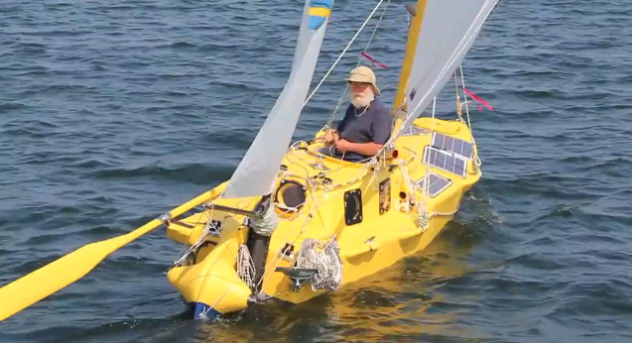 History
History  History
History  Weird Stuff
Weird Stuff 10 Niche Subcultures That Are More Popular Than You Might Think
 Mysteries
Mysteries 10 Tragic Disappearances and Deaths in Joshua Tree National Park
 History
History 10 Ways Childhood Really Sucked in the Old West
 Music
Music 10 Name Origins of Famous Bands from the 1990s
 Religion
Religion 10 Biggest Turnarounds by the Catholic Church
 Weird Stuff
Weird Stuff 10 Unbelievable Times Laws Had Unintended Consequences
 Humans
Humans Ten Historic Women Who Deserve Way More Credit Than They Got
 Movies and TV
Movies and TV 10 Films That Spawned Major Lawsuits
 History
History Ten Times Towns Were Wiped Off the Face of the Earth
 History
History 10 Amazing Roman Epitaphs
 Weird Stuff
Weird Stuff 10 Niche Subcultures That Are More Popular Than You Might Think
 Mysteries
Mysteries 10 Tragic Disappearances and Deaths in Joshua Tree National Park
Who's Behind Listverse?

Jamie Frater
Head Editor
Jamie founded Listverse due to an insatiable desire to share fascinating, obscure, and bizarre facts. He has been a guest speaker on numerous national radio and television stations and is a five time published author.
More About Us History
History 10 Ways Childhood Really Sucked in the Old West
 Music
Music 10 Name Origins of Famous Bands from the 1990s
 Religion
Religion 10 Biggest Turnarounds by the Catholic Church
 Weird Stuff
Weird Stuff 10 Unbelievable Times Laws Had Unintended Consequences
 Humans
Humans Ten Historic Women Who Deserve Way More Credit Than They Got
 Movies and TV
Movies and TV 10 Films That Spawned Major Lawsuits
 History
History Ten Times Towns Were Wiped Off the Face of the Earth
10 Smallest Things Of Their Kind In The World
We recently took a look (at a great distance) at some of the world’s very largest things of their kind. After all that mind-boggling immensity, we decided it’d be fun to go in the other direction and scale down . . . way, way down. All of the things on this list are man-made, and they are all functional, just like their regular-sized counterparts.
10 Gun

According to the company website, the Swiss MiniGun is “a double action revolver and has all the same features as are found on a real size gun.” As the name implies, the gun and its components are Swiss-made, which kind of makes sense—a country famous for the quality of its clocks and watches should have no trouble with a working pistol the size of a thumb drive.
The six-shot revolver fires 2.3-caliber, 1.97-grain bullets, which are made by the same company, and even produces a tiny little kick as it shoots these tiny little bullets at a muzzle velocity of around 400 feet per second—right around the same as your average child’s BB gun and capable of doing about the same amount of damage.
Of course, there are still those who are up in arms, so to speak, about the alleged weapon’s potential concealability, which we suppose is a valid argument. Even the slowest, smallest projectile can injure or kill if placed properly, and despite the fact that it looks almost exactly like a key chain, the Swiss MiniGun is, in fact, a gun—the smallest in the world.
9 Model Train Set

The little countryside diorama seen above is impressive enough in its incredibly small scale, but look closely— there’s a train track, and a five-car train runs around and around on it. It’s the world’s tiniest model train, and it was built by New Jersey model train enthusiast David Smith for about $12.
It’s part of a larger, very post-modern project—another large train set, which is an entire model village that contains . . . a model of a model shop, with smaller models inside. This little thing is powered by a five-centimeter (two inch) motor carved out of plastic. In fact, all of the parts were carved out of plastic by hand—the hand that is holding the finished work in the picture above, which just doesn’t seem possible.
Smith says that the entire larger project, which he calls “James River Branch,” will take him two and a half years to complete, and “is going to be very impressive once it is finished,” demonstrating a consistent gift for understatement. In terms of scale, the larger village is being built to 1:220. This little model train, the smallest anywhere, is built to 1:35,200 scale. Here is a video of it in action.
8 Car

First manufactured from 1962 to 1965, the Peel P50 Microcar gained renewed attention after 6’5″ Jeremy Clarkson took one for a drive on a 2008 episode of the popular British TV series Top Gear. The smallest production car ever was sold in Great Britain for about £200; its 49cc engine was mated to a three-speed manual transmission (no reverse), and it also had three wheels. Other than that, they had one of everything: one seat, one door, one windshield wiper, and one headlight.
In its original run, only about 50 were made. Thanks to renewed interest in minis (not to mention the exposure on Top Gear), the company has been revived after a slight hiatus of 50 years. The new Peels are almost exact replicas and come in gas or electric. The P50 now tops out at 72 kilometers per hour (45 mph), as opposed to about 56 kph (35 mph) for the original, with the slightly larger two-headlight Trident model managing about 69 kph (43 mph). The P50 is 137 centimeters (54 in) long—less than 1.6 meters (5.5 ft).
We know what you’re thinking: What kind of mileage do they get? The gas model P50 delivers better than 241 kilometers (150 mi) to the gallon, with the Trident getting a whopping 338 kpg (210 mpg)—which sounds great, until you consider that the gas tank must have roughly the capacity of your average lawnmower. Strangely, the company website doesn’t mention gas tank capacity.
7 Camera

In 2011, researchers at Germany’s Fraunhofer Institute introduced a new kind of disposable camera. While this in itself may not sound particularly impressive, its medical application—capturing images inside the body—is very valuable, and it can do this because of its freakish size. These easy-to-manufacture, inexpensive disposable cameras are one cubic millimeter, or about the size of a coarse grain of salt.
The cameras are meant to be disposed of after one medical procedure, and while their resolution doesn’t seem spectacular (0.06 megapixels—far less than even a cheap cell phone), it’s good enough for the job they were designed for. And their size makes them able to get to places within the body that, obviously, no other camera could. (Yes, that’s a syringe in the picture above.)
Also, they could be an effective replacement for standard endoscopes, which are expensive and costly to maintain. It seems a matter of time, as well, before we start hearing about the applications of such tiny image sensors in consumer products. It also seems likely, judging by the last decade or two of explosive technological leaps, that the resolution will improve dramatically, and soon.
6 Personal Computer

Speaking of which, Norway’s FXI technologies has brought to market a personal microcomputer, in the truest sense of the word. That machine in the image is not a USB drive; in fact, there is a micro USB port on that machine. It is the FXI Cotton Candy, and it’s a fully functional PC capable of running Android or Ubuntu operating systems.
Specifications? Absolutely: a 1.2 GHz dual core ARM main processor and a 1 GHz quad-core ARM graphics processor, with 1 GB of RAM memory and a micro SD card slot capable of supporting up to 64 GB of storage. FXI will load it for you with either operating system, and it also packs Wi-Fi, Bluetooth, and full 1080p HD video output.
A keyboard/mouse combo can easily be connected to its micro USB port, and it’s easy to connect to any standard HD display as shown in this video. The price? According to the company website, the price is $200. The video link shows one of these computers running Android and flawlessly playing a full HD video file. Since we literally have cheap, reasonably powerful personal computers smaller than our thumbs, we’re thinking it’s now safe to refer to the era in which we’re living as “the future.”
5 Ocean-Faring Vessel

Sven Yrvind of Sweden is a respected, master boat-builder, which is the only reason anyone believes the septuagenarian (74 as of 2013) when he tells them what his plan is. He’s building a boat in which he will sail around the world, but not just any boat—the smallest ocean-faring boat ever built, which is roughly the size of a large hot tub. In it, Sven plans to circumnavigate the globe, nonstop without docking, in about a year and a half.
Sven insists that the diminutive size of the boat doesn’t increase the danger of the mission, since larger boats have more mass with which to cause havoc when the ocean doesn’t cooperate. He says his craft is designed to be tossed about, pitched, and even capsized—only to bob back to the surface like a cork. It’s 1.5 tons of fiberglass cork smashed into just three meters (10 ft), but a cork nonetheless.
The boat is equipped with gel batteries and a foot crank for power, can also harness wind and solar energy, and can collect and purify rainwater. He’ll be bringing along just enough food—800 pounds of muesli and sardines—to complete the trip. Why sail around the world in such a tiny vessel? Sven said, “I want to show people that we can live in a small space and still be happy . . . We need to get back to nature. We need to hear and listen to our inner voice.” We wish him luck, and hope that he doesn’t get sick and tired of said inner voice on his trip.
4 Television Screen

In 2007, Guinness World Records recognized Scottish firm MicroEmissive’s ME1602 as the smallest television screen in existence. As of this writing—and despite the aforementioned tech explosions of recent years—it’s a record that still stands.
Sure, the resolution isn’t great. With a display of roughly 4×3 millimeters in surface area, there are only so many pixels you can cram in there (160×120—almost 30,000 pixels).
But the little displays are mainly used as components in viewfinders and other things that require, well, extremely tiny embedded displays. In August 2013, the company signed a pretty rich deal with an “unnamed Asian consumer-products manufacturer” to provide displays for them. Inquiries have also come in from the medical establishment and, of course, the military.
Since we know some of you are curious (we sure were), we did the math: Remember the largest video screen in the world from the previous list? You could fit 283,333,333 of the smallest screens in the world inside of it.
3 Jet Airplane

From the late 1960s to mid-1970s, the Bede Aircraft Corporation, a small company led by US plane designer Jim Bede, manufactured a kit for a small aircraft that sold over 5,000 units. This craft, the Bede BD-5J was, is, and is likely to remain the smallest jet-powered aircraft in the world, weighing just over 350 pounds.
Since the company discontinued due to its bankruptcy, only a few hundred of the kits were completed, but they are remarkably sound, fully functional jet planes capable of speeds up to 483 kilometers per hour (300 mph) on 225 pounds of thrust from its Sermel TRS 18 Microturbo jet engine. The planes were popular in the ’80s in airshows, and also turned up in beer commercials and the opening sequence of the James Bond film Octopussy.
Specs varied by model, but generally, the BD-5J has a four- to six-meter (14–20 ft) wingspan, can weigh no more than about 1,000 pounds on takeoff, has a range of about 483 kilometers (300 mi), and a maximum cruising altitude of 7,010 meters (23,000 ft)—fine for a jetliner, but (we imagine) abjectly terrifying in a craft no larger than your average sedan.
2 Drone

Yes, it is technically a drone, but the RoboBee is, well, exactly what the name implies: a very, very small drone that is directly inspired by insect biology. And it has many interesting potential applications beyond just spying.
For instance, it’s easy to imagine swarms of robot bees being very useful in hazardous environment assessments, say, in the aftermath of a nuclear plant accident or a natural disaster, or in search-and-rescue situations. Roboticists at Harvard, where the RoboBee was developed, also see them perhaps being used in weather and traffic monitoring, climate mapping, and other such already-entrenched technologies that the drones could further improve.
For that matter, you may have heard that actual honeybee colonies have been declining, potentially causing a host of problems for the rest of the planet’s creatures. This may not be so worrisome if we are able to deploy vast swarms of artificial bees, programmed to pollinate just like real ones, to compensate—another very realistic task for the RoboBee.
1 Artificial Heart

Finally, we have this little device, created by Dr. Robert Jarvik—the man many credit with the invention and perfection of the artificial heart. And that’s exactly what that battery-sized device is: the world’s smallest artificial heart, for the world’s smallest artificial heart patient.
The 16-month-old baby had dilated cardiomyopathy, a degenerative condition of the heart wall, and was awaiting a transplant. But with no donor immediately forthcoming, doctors were forced to improvise. Jarvik’s device, an implantable pump weighing all of 11 grams (an adult artificial heart weighs 900 grams), had only been tested on animals. (It is connected to tubes that must run outside the body, thus escalating the risk of infection.) But in May 2012, with nothing to lose, the doctors proceeded to remove the infant’s heart and replace it with the device in the image above, where it remained for 13 days.
This was, of course, how long it took for a transplant donor to be found, and while the device would not have kept the patient alive indefinitely, the doctors who participated say that this could definitely be on the horizon. We find this to likely be an understatement. At the rate technology continues to shrink, we can see an easily removable, shot glass–sized RoboHeart with a 300-year warranty on the shelf before we’re old enough to need one.








